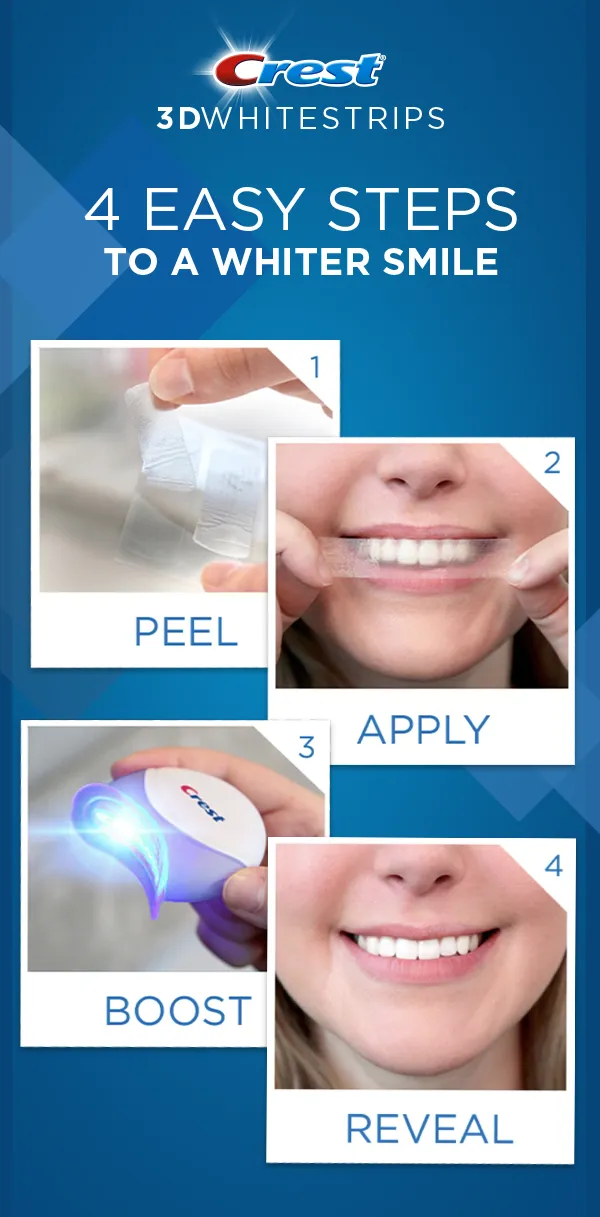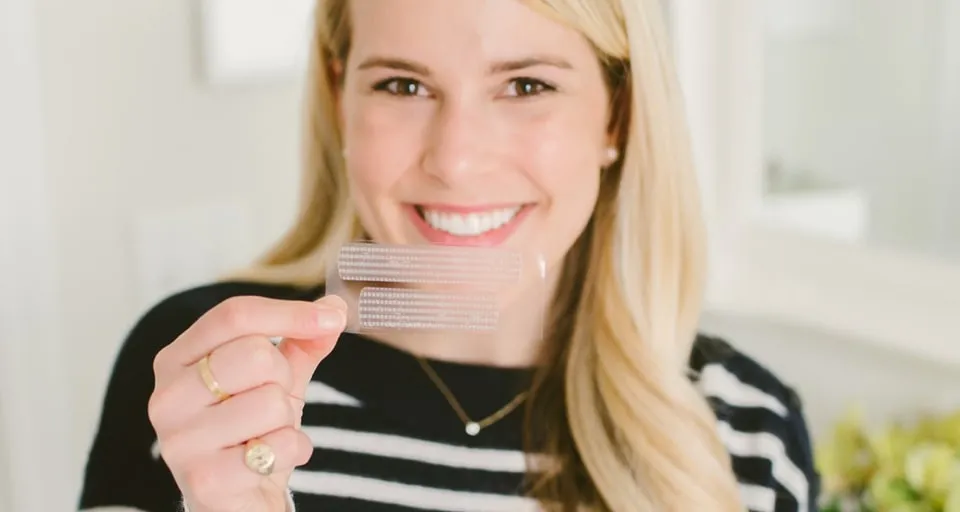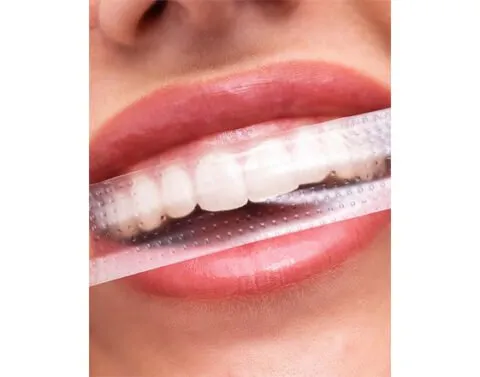Understanding Teeth Whitening Strips
Teeth whitening strips have become a popular and accessible method for enhancing the brightness of your smile. These thin, flexible strips are coated with a whitening agent, typically hydrogen peroxide or carbamide peroxide, that helps to remove stains and discoloration from the surface of your teeth. They offer a convenient alternative to professional whitening treatments, allowing users to improve their teeth’s appearance from the comfort of their own homes. However, to achieve the best results, it’s important to understand how these strips work and how to use them effectively. Proper usage not only maximizes their whitening potential but also minimizes the risk of any potential side effects. This guide will delve into the science behind teeth whitening strips and provide you with the essential knowledge to achieve a dazzling smile.
How Do Teeth Whitening Strips Work?
Teeth whitening strips function through a chemical process. The active ingredients, usually hydrogen peroxide or carbamide peroxide, penetrate the enamel of the teeth. These compounds break down into smaller molecules that react with the stain molecules embedded within the enamel. As a result, these stain molecules are broken down and dispersed, leading to a brighter, whiter appearance of the teeth. The peroxide acts as an oxidizing agent, effectively lifting away stains caused by coffee, tea, wine, and other common culprits. The effectiveness of the strips depends on the concentration of the active ingredient, the contact time, and the consistency of use. Different brands and formulations offer varying levels of these factors, so choosing the right product is vital for optimal results. Understanding this process is crucial for setting realistic expectations and knowing how to use the strips correctly.
Ingredients and Their Impact

The primary active ingredients in teeth whitening strips are hydrogen peroxide and carbamide peroxide. Hydrogen peroxide is a stronger, more direct whitening agent and can produce faster results. Carbamide peroxide, on the other hand, breaks down into hydrogen peroxide and urea, offering a slightly gentler approach. The concentration of these ingredients varies among products, influencing the whitening power and the potential for sensitivity. Higher concentrations may yield quicker results but can also increase the likelihood of tooth sensitivity or gum irritation. Besides the active ingredients, the strips contain other components such as binding agents to ensure the strips adhere to the teeth, and flavoring agents to improve taste. Understanding the ingredients and their concentrations can help you select a product that aligns with your needs and sensitivity levels. Reading the product labels carefully and consulting with a dentist can provide further guidance.
Top 5 Secrets for Using Teeth Whitening Strips
Secret 1 Consistent Application
Consistency is a cornerstone of successful teeth whitening. The effectiveness of teeth whitening strips largely depends on their consistent use as directed by the manufacturer. Skipping applications or using them sporadically can significantly diminish the results. Adhering to a regular schedule allows the whitening agents to work progressively, gradually removing stains and brightening your teeth. This consistent approach ensures that the active ingredients have ample time to penetrate the enamel and break down the stain molecules. To stay consistent, integrate the application of teeth whitening strips into your daily routine, perhaps after your morning or evening teeth brushing. Setting reminders can help you stay on track, ensuring that you don’t miss any applications. Remember, consistency is key to achieving and maintaining a dazzling white smile.
How Often to Apply

The frequency of application is typically outlined on the product packaging. Most teeth whitening strips recommend use once or twice daily for a specific duration, often ranging from 14 to 30 days. The precise instructions can vary depending on the product’s concentration of active ingredients and the brand’s recommendations. It’s crucial to follow these instructions meticulously to avoid both underuse, which might not produce desired results, and overuse, which could lead to sensitivity or gum irritation. Pay close attention to the recommended application time, as well, which may be 30 minutes or longer. Never exceed the recommended frequency or duration. If you have any questions or concerns, consult the dentist to avoid any potential dental issues or undesired results.
The Importance of a Routine
Establishing a routine is essential for consistent use. A well-defined routine helps you integrate the application of teeth whitening strips into your daily habits. This could involve applying the strips at the same time each day, such as immediately after brushing your teeth in the morning or before going to bed at night. Consider setting a reminder on your phone or placing the strips in a visible spot to prompt consistent application. A routine not only ensures that you don’t miss applications but also helps you track your progress. By making teeth whitening strips part of your routine, you increase the likelihood of achieving and maintaining a brighter smile. Consistency and commitment are key to the most effective results, so make it a habit!
Secret 2 Prep Your Teeth
Preparing your teeth before applying teeth whitening strips enhances their effectiveness. Start by brushing and flossing your teeth to remove any food particles and surface debris that could impede the whitening agents. Ensure your teeth are dry before applying the strips, as moisture can reduce adhesion and effectiveness. Avoid brushing immediately before applying the strips; wait for approximately 30 minutes after brushing to prevent potential sensitivity. A clean, dry surface allows the whitening agents to make optimal contact with your teeth, maximizing their ability to penetrate and lift stains. By taking these simple preparatory steps, you can ensure that your teeth whitening strips work efficiently, leading to better and faster results.
Brushing and Flossing Before

Brushing and flossing before applying the strips are crucial steps in the preparation process. Brushing removes surface stains, plaque, and food debris that can hinder the whitening process. Flossing eliminates any lingering particles and ensures that the whitening agents can reach all areas of your teeth, including those between your teeth where discoloration often occurs. However, it’s essential to wait at least 30 minutes after brushing before applying the strips to allow the enamel to re-mineralize and minimize any potential sensitivity. This comprehensive cleaning routine sets the stage for the whitening strips to work efficiently, helping them penetrate the teeth’s surface and achieve optimal results.
Avoiding Staining Foods
During and after your teeth whitening treatment, it’s important to avoid foods and drinks that can stain your teeth. These include coffee, tea, red wine, dark sodas, berries, and other heavily pigmented foods. These substances can quickly counteract the whitening effects and lead to re-staining. Consider using a straw when drinking staining beverages to minimize direct contact with your teeth. Furthermore, it is advisable to brush your teeth after consuming staining foods or drinks, if possible. By reducing or eliminating these staining agents, you can extend the life of your whitening results and maintain a brighter smile.
Secret 3 Time is Key
The duration of time the teeth whitening strips are in contact with your teeth significantly impacts the effectiveness and the potential for side effects. Carefully adhere to the manufacturer’s recommended application time, which usually ranges from 30 minutes to an hour. Leaving the strips on longer than advised does not necessarily enhance whitening but could increase the risk of sensitivity or gum irritation. Conversely, removing the strips before the recommended time may diminish the results. Pay close attention to the instructions on the packaging and set a timer to ensure you stay within the recommended application window. This adherence to the guidelines is essential for achieving the best whitening results while minimizing any potential adverse effects.
Recommended Application Times

Recommended application times vary depending on the specific product and the concentration of the whitening agent. Always refer to the product’s instructions for precise guidelines. Most strips recommend leaving them on for a period of 30 minutes to an hour, once or twice daily. Some advanced formulations may require shorter or longer application times. It is critical to follow the manufacturer’s guidance precisely to avoid damaging your teeth. If you have any uncertainty about the recommended time, consult your dentist. They can provide personalized advice based on the sensitivity of your teeth and the desired whitening level.
Avoiding Overuse
Overuse of teeth whitening strips can lead to negative consequences, including increased tooth sensitivity and gum irritation. Exceeding the recommended frequency or duration of use can damage the enamel, making your teeth more vulnerable. If you notice any increased sensitivity, discontinue use immediately and consult your dentist. It’s essential to follow the manufacturer’s guidelines to prevent adverse effects. Regular dental check-ups can help monitor your oral health and ensure you’re using the strips safely. Remember, moderation is key. Always prioritize the health of your teeth over the pursuit of a brighter smile.
Secret 4 Maintain After Whitening
Maintaining your newly whitened smile requires a combination of preventive measures and ongoing care. Once you’ve achieved your desired level of whiteness, it is essential to maintain the results through appropriate oral hygiene practices and by avoiding staining foods and beverages. Regularly brush your teeth twice a day and floss daily to remove any food debris and prevent further staining. Consider using a whitening toothpaste or mouthwash to help maintain the brightness. Schedule regular dental cleanings to professionally remove any surface stains and keep your teeth healthy and bright. By adopting these consistent habits, you can enjoy a long-lasting, dazzling smile.
Preventing Staining

Preventing staining is a key component of maintaining a white smile. Be mindful of foods and drinks that can stain your teeth, such as coffee, tea, red wine, and dark-colored sodas. Minimize your consumption of these beverages or use a straw to reduce contact with your teeth. Brush your teeth after consuming staining foods or drinks to remove any surface stains before they set in. Additionally, quit smoking, as smoking significantly contributes to tooth discoloration. Regular dental check-ups and cleanings can also help in removing surface stains and preventing further discoloration. By making informed choices about your diet and lifestyle, you can preserve the brilliance of your whitened smile.
Maintenance Products
Several maintenance products can help you maintain your bright smile. Whitening toothpastes and mouthwashes contain mild abrasive agents or whitening ingredients to help remove surface stains and keep your teeth looking bright. These products are excellent for everyday use and can be incorporated into your regular oral hygiene routine. Consider using a whitening toothpaste or mouthwash in conjunction with your regular brushing and flossing. Additionally, over-the-counter whitening gels or touch-up strips can be used periodically to address any minor discoloration that might appear over time. Consult your dentist for recommendations on the best maintenance products for your specific needs. Remember that consistent use and attention to detail are essential for maintaining a radiant, white smile.
Secret 5 Consult Your Dentist
Before starting any teeth whitening treatment, including using teeth whitening strips, consulting with your dentist is vital. A dentist can evaluate the health of your teeth and gums to determine if whitening strips are appropriate for you. They can identify any underlying issues, such as cavities, gum disease, or existing dental work, that could be affected by the treatment. Your dentist can provide personalized recommendations, suggest alternative whitening methods, or advise on how to use teeth whitening strips safely and effectively. They can also monitor your progress and address any concerns or side effects you may experience. Taking this step ensures the safety and effectiveness of your teeth whitening journey, giving you peace of mind and optimal results.
When to Seek Professional Advice

It’s essential to know when to seek professional advice. Consult your dentist immediately if you experience any unusual sensitivity, persistent gum irritation, or changes in your teeth’s appearance. If your teeth whitening strips cause discomfort or pain, stop using them and make an appointment with your dentist. Any signs of gum recession or tooth damage should also be addressed by a dental professional. Regular dental check-ups and professional cleanings are crucial to monitor your oral health. Your dentist can assess the effectiveness of the teeth whitening treatment, address any concerns, and help you achieve your desired results safely and effectively.
Potential Risks and Side Effects
While teeth whitening strips are generally safe, they can cause some side effects and potential risks. The most common side effects are increased tooth sensitivity and mild gum irritation. These symptoms are usually temporary and disappear once you stop using the strips or reduce the frequency of use. In rare cases, prolonged use or overuse can lead to damage to the enamel or soft tissues. If you have any existing dental problems, such as cavities, gum disease, or sensitive teeth, whitening strips may exacerbate these issues. Always follow the instructions carefully, and consult your dentist if you experience any adverse reactions. They can provide you with guidance and advice to minimize the risks and ensure a healthy, brighter smile.
Conclusion
Achieving a dazzling, white smile with teeth whitening strips requires more than just applying the strips. Understanding how they work, following the instructions, and practicing a consistent routine are all essential. By adhering to the top 5 secrets outlined in this guide, you can maximize your results while minimizing any potential risks. Remember to consult your dentist before starting and to seek professional advice if you experience any adverse effects. Maintaining a bright smile is an ongoing process. Proper oral hygiene, avoidance of staining foods and drinks, and regular dental check-ups all contribute to long-term success. With careful planning and attention, you can confidently achieve and maintain the radiant, white smile you have always desired.
